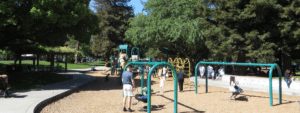This article was originally published on October 30, 2014 on Streetsblog San Francisco.
By Andrew Boone
Last week, just two weeks before San Bruno voters choose whether or not to approve the Measure N ballot measure, city officials finally cleared the last legal hurdle for the measure, which would modify building height limits that voters set in 1977 with Ordinance 1284. That ordinance required a “town-hall type of hearing whereby experts, proponents, and opponents may be heard and questioned by voters,” so last Tuesday, a debate was held between San Bruno Mayor Jim Ruane and Peninsula Health Care District Board of Directors candidate Doug Radtke.
Ordinance 1284 limits all new building heights in San Bruno to 50 feet or three stories, caps residential zoning densities to those set forty years ago, and bans multi-story parking structures — unless a specific development project is approved by a majority of voters. If Measure N is approved, maximum building heights will increase to 90 feet (five stories) within one block of the new Caltrain station, to 70 feet along El Camino Real, to 65 feet along San Bruno and Huntington avenues, and to 55 feet along San Mateo Avenue. The measure would also repeal Ordinance 1284′s ban on multi-story parking structures, which will “help solve parking needs as the downtown becomes more vibrant and parking demand increases,” according to the city’s Measure N FAQ sheet.
City planners say the higher building heights and residential densities specified in Measure N are critical to implement San Bruno’s Transit Corridors Plan, which aims to enable the development, over the next 20 years, of a higher-density residential and commercial area within walking distance of the city’s new Caltrain station. The station was reconstructed half a mile north of its isolated former location at Sylvan Avenue, opening in April as an elevated structure at the intersection of the city’s two main streets, San Mateo and San Bruno avenues.
“We expect full build-out to result in 4,000 additional jobs, 2,400 of which are a direct result of passing Measure N,” said Ruane, quoting a fiscal and economic impact report authored by consulting firm Economic & Planning Systems. “It would increase the population by 3,784 in the Transit Corridors Area, [with] Measure N accounting for 1,558.”
This means that over the plan’s 20-year time frame, Measure N would result in 120 more jobs and 78 more new residents per year. “But we have to make it attractive for developers to come in here, if you want to clean a lot of the downtown up,” said Mayor Ruane.
Radtke, who represented the opposition to Measure N at the city-hosted debate, said that the additional development allowed by the measure will raise living expenses for current residents, and raised the specter of anticipated downtown developments drawing outsiders to the town.
“Single-family homes are bastions of the middle class. Catering to [potential office tenants] YouTube and Walmart is basically going to end that era. It’s going to be the tech class — San Franciscans, not San Brunans,” said Radtke. “Property values will go up, and with that comes increased costs… It throws the residents of San Bruno pretty much under the bus.” Radtke did not note that over 40 percent of San Brunans live in multi-family houses, and did not offer foolproof methods that would keep “the tech class” out of a town that straddles all four major transportation arteries between San Francisco and Silicon Valley.
The Daily Journal endorsed Measure N in an editorial last month. “San Bruno, and the rest of the Peninsula, was a far different place in 1977,” wrote the newspaper, referring to the year Ordinance 1284 was passed by voters. “San Bruno is stuck with an old set of rules that prohibit many new opportunities from coming to the city.” The San Bruno Chamber of Commerce, San Mateo County Housing Leadership Council, and Greenbelt Alliance are also among the groups urging San Bruno residents to vote Yes on Measure N.




